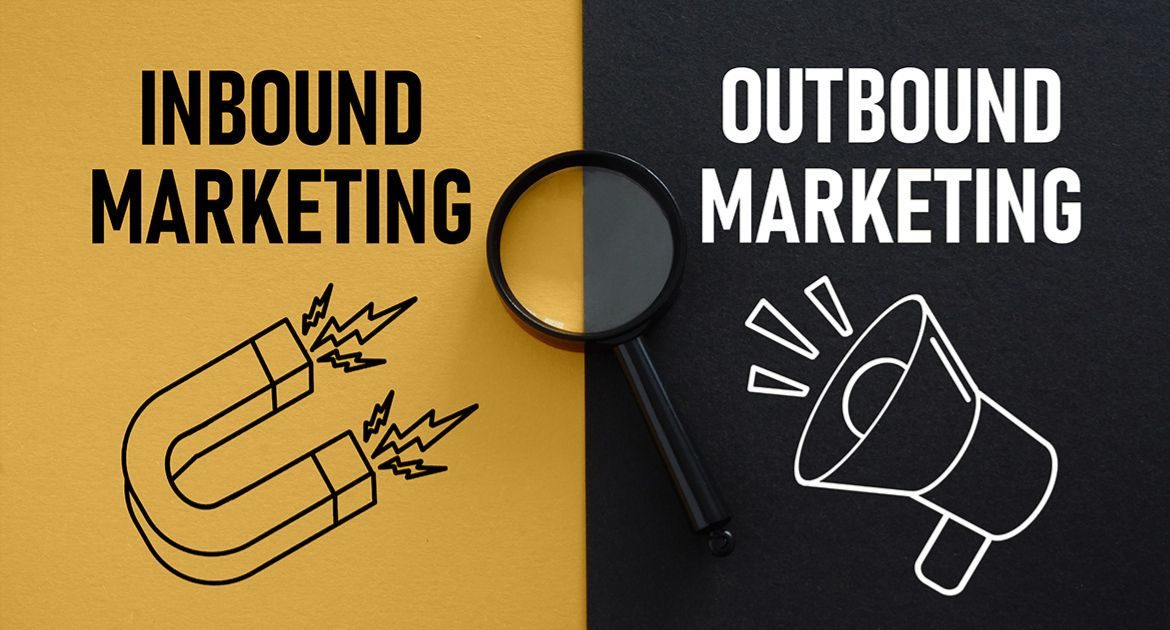Inbound vs Outbound Marketing in B2B: which works best?

If you’re a technology, engineering or software company, you’ve almost certainly relied on those tried-and-tested B2B outbound marketing strategies to grow your customer base, expand your reach and achieve your revenue goals.
This might include sending direct letters and emails to other businesses, paying for display advertising in the trade press and websites, creating brochures and flyers or even using telephone cold-calling techniques that did deliver results.
However, since the digital revolution and the COVID pandemic, consumer habits have changed the landscape and now inbound marketing for B2B dominates the marketing arena.
What used to be done face-to-face or with physical products is often done online now that businesses and individuals have adapted to the challenges posed by COVID and the vast potential that the digital environment offers.
As a result, more conferences, training sessions and meetings are held online than ever before, and the number of online purchases has exploded. Inbound marketing (blog posts, social media posts, SEO, email broadcasts, digital media, YouTube videos and online events) now dominates the space.
So, which would work best for your technology, engineering, software or manufacturing company? Should you embrace inbound marketing for B2B or stick with outbound?
In this article, we will explain what inbound and outbound marketing are, the benefits and limitations of each and which you should use for your B2B business.
What are the pros of inbound marketing?
What are the cons of inbound marketing?
What are the pros of outbound marketing?
What are the cons of outbound marketing?
Inbound or outbound? Which is best?
What is inbound marketing?
Inbound marketing is where most of the action is these days in the modern marketing space.
It’s a methodology that attracts your potential clients by providing engaging content that offers value. This includes things like blog posts, social media posts, SEO (search engine optimisation), email broadcasts, digital media, YouTube videos and online events.
Designed to solve people’s problems at each stage of the buyer’s journey, it can help attract and nurture leads and convert them into paying clients or customers.
An inbound marketing strategy is created by considering the unique needs of the client or customer, where they are in the buyer journey (whether they’re searching for a solution, narrowing down the options available or ready to decide) and then using this data to create marketing strategies that deliver real results.
Unlike traditional forms of marketing, inbound isn’t ‘one-size-fits-all’ but instead provides specific messaging for specific customers and therefore can connect with prospects, provide solutions and help boost conversions.
Because the content is created with the specific buyer personas in mind, it also helps prospects feel that you really understand their needs and can potentially provide a solution.
This doesn’t only boost sales but can also increase customer loyalty and trust, position you as the leader in your particular industry and build your business success as a result. It builds the brand and drives new business.
Finally, inbound marketing is easily measurable, thanks to the various digital tools available. By looking at these metrics, your inbound marketing agency can get solid data on the type of messaging or content that works and tweak the overall strategy accordingly.
What are the pros of inbound marketing?
Inbound marketing has thrived thanks to the digital revolution and the fact that people are now spending more time on their computers, tablets and mobile devices than ever before.
According to Ofcom’s Online Nation Report 2022, UK adults now spend around 4 hours per day online, with the figure even higher for those industries such as engineering, technology, manufacturing and software companies that already use digital tools in the workplace. For example, in our industry there’s hardly a moment when we are not on our computers, especially as more than half our employees work from home.
Inbound marketing is also a cost-efficient and non-invasive marketing strategy (it used to be called ‘permission’ as opposed to ‘interruption’ marketing) that helps raise awareness of a service, product or brand and continuously generate quality leads. It’s also easily measurable by using the myriad of online content marketing tools that are now available.
What are the cons of inbound marketing?
Although inbound marketing is a modern and highly effective option that suits all types of industries, there are certain disadvantages. For example, it’s a long-term approach that doesn’t usually deliver immediate results but takes time and effort instead.
Inbound marketing agencies and teams must also continually monitor potential client or customer behaviour and adjust their content marketing strategy to meet the ever-changing needs of the consumer.
However, when done effectively, it usually delivers outstanding results that engages prospects and positions the brand or company as a leader in their industry, builds trust and loyalty, connects with the deeper needs of the audience and helps build future business success.
What is outbound marketing?
Outbound marketing is a more traditional form of marketing that delivers your marketing message directly to a large group of people via direct mail, newspaper and magazine adverts, tv and radio advertising, sponsorships, PR, cold calling and billboards.
This non-digital form of marketing is based on the concept of marketing at scale – the larger the group of people who see the marketing message, the larger the potential return.
With outbound marketing, the customer usually isn’t looking to buy a specific product or sign up for a particular service. Instead, they’re going about their daily life, for example listening to the radio on their commute when their concentration is interrupted and they are presented with an advertising message.
What are the pros of outbound marketing?
Outbound marketing is more traditional, and people are used to receiving promotional marketing materials and seeing adverts in printed media, billboards and on television, for example.
People tend to trust this type of marketing more than inbound or digital marketing. It can also lead to immediate results and higher conversion rates, and be an excellent way to boost brand awareness.
What are the cons of outbound marketing?
Despite the benefits of outbound marketing, it is more generalised and people’s familiarity with it can make it easier for them to ‘tune out’. Unfortunately, it can often be irritating and intrusive for the potential customer and associated with sleazy sales techniques or pushy salespeople.
As we mentioned earlier, the digital marketing revolution has largely destroyed traditional media, resulting in much fewer opportunities in outbound marketing these days.
Businesses and individuals are more accustomed to making purchases, conducting business, holding meetings or conferences and communicating with their clients or customers online than ever before. Alongside the Data Protection rules (GDPR) that came into effect in 2018, outbound marketing is harder than it has ever been.
Finally, outbound marketing tends to be more expensive than digital marketing. Although it can often deliver faster results, the ROI is much lower than with inbound content marketing.
Inbound or outbound? Which is best?
From reading this article, you may be thinking that inbound marketing is the savviest and most cost-effective marketing approach for tech, engineering and software companies, manufacturers and other types of businesses. However, whether you choose inbound or outbound marketing for B2B depends entirely on your circumstances, budget and industry.
It usually works best to use a tailor-made combination of marketing strategies that work together to achieve your goals and help deliver the best of both worlds.
Here are some factors you should consider:
Your marketing budget
If you’re a startup tech company or have a tighter marketing budget, it’s usually better to start with inbound marketing as it is more affordable and maximises your ROI. However, if you’re more established, combining inbound marketing with outbound can be an effective option as it combines the best of both worlds.
Your target markets
B2B inbound marketing works very effectively for niche markets as it allows you to monitor your efforts, discover what marketing content engages your website visitors best and tailor your efforts for maximum ROI. However, if you’re targeting a mass market, outbound marketing can be extremely effective and help you stand out in a saturated market.
Your specific industry
Industries such as engineering, technology, software and manufacturing usually have a long tradition of using outbound marketing and, instead, rely on traditional sales reps to close any sales instead of digital marketing.
Although outbound remains an excellent option, using inbound marketing strategies for B2B offers more modern alternatives that help your company stand out from your competitors and build a loyal and lasting relationship.
Summary
Whilst the digital revolution has largely killed traditional media and inbound marketing for B2B dominates the landscape, companies in technology, engineering, software and manufacturing could still benefit from traditional outbound marketing when done effectively.
However, as we’re sure you’ll agree, inbound marketing is, without a doubt, the most effective, strategic and affordable marketing solution for the 21st century and can help attract and convert your leads for better ROI.
Contact us to find out how we can help accelerate your business growth and generate better revenue with outstanding, tailor-made marketing for B2B today.
Related Posts
-
Time was, you needed an agency to provide those marketing sk...Jan 26, 2014 / 0 comments
-
With 53m followers on Facebook, a Wall Street valuation of $...Jul 29, 2014 / 0 comments
-
Love it or hate it, Christmas is the one time of the year th...Nov 16, 2013 / 0 comments
-
We’ve come a long way since Austin gave Peter Sellers a Mi...Feb 04, 2015 / 0 comments
Recent Posts
- Marketing is War! Marketers must be prepared for the future, whatever it brings.
- Gain buy-in from the C-suite: how to influence the Boardroom
- Are trade shows worth it? The value of B2B trade events
- Successful business networking with B2B events: How to make them work for you
- Innovative B2B brand building strategies for 2024: Our top tips
Copyright © 2024 Marcom (Marketing Communications) Ltd. All rights reserved.
Cookies & Privacy Policy. This site is protected by reCAPTCHA and the Google Privacy Policy and Terms of Service apply.









Sorry, the comment form is closed at this time.